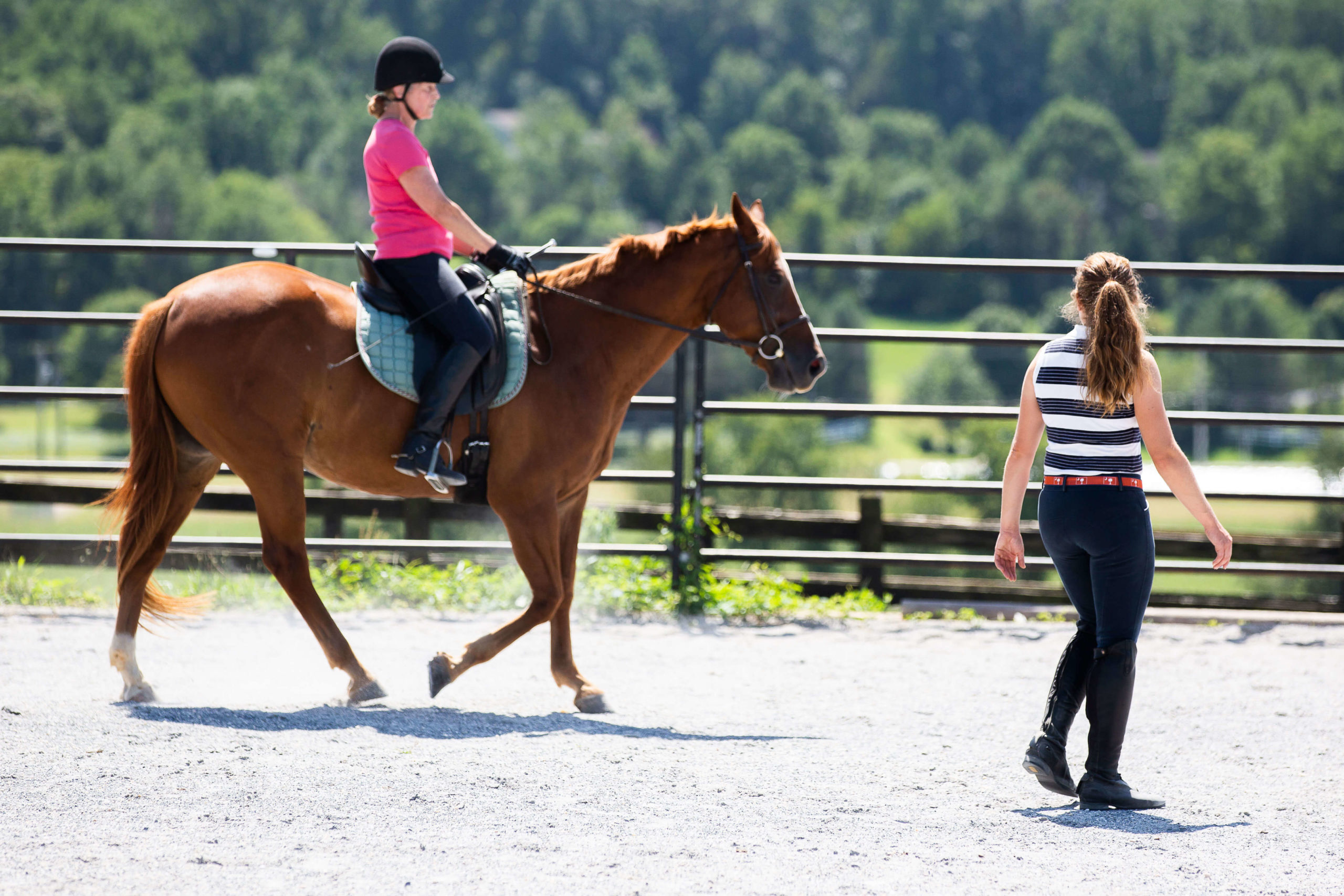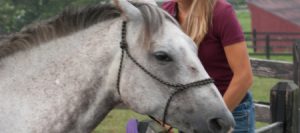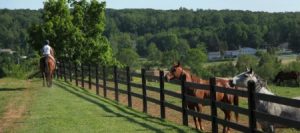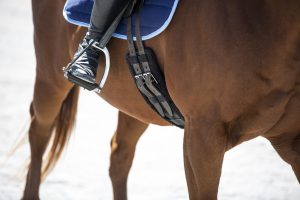In the last article and video, we talked about how riding involves more than just your technique as a rider, and how seeing the big picture can bring clarity to riding challenges.
I also mentioned my belief that every rider is a trainer, and that every ride we have, every interaction with a horse, matters.
The horse is learning something, whether you are aware of that learning is or choosing to ignore it.
You and your horse’s skills never stay the same, they are either improving or they’re getting worse, depending on your practice
[Tweet “You and your horse’s skills never stay the same, they are either improving or they’re getting worse, depending on your practice.”]
Whether you ride school horses, a friend’s horse now and then, or “you’re just out for a short hack – this isn’t a training session.” Every ride is training.
Here’s three reasons why this is true:
First, horses are always learning, and I don’t mean always learning something “new”. The process may be more subtle, but behavior is always changing. Horses learn how to behave around specific people, how to feel in different locations, what to do more of and what to do less of. Even in the context of one ride, how a horse behaves or moves, can change.
Second, the longer the horse does something, the more difficult it will become to get him doing something different, that’s just how brains work and I’ll explain more later.
Third, the horse is a living, emotional, and social animal. Our relationship with them matters, whether you are thinking of your horse that you’ve owned for ten years or a horse that you may just ride in one lesson. Relationship matters and every interaction will either improve or erode that relationship.
If we believe that our actions and emotions do not impact the horses we ride in any meaningful way, we miss a huge benefit of the “specialness” of riding. What sets it apart from most other activities is the interaction we have with the horse – learning to understand them and to communicate our requests from their back – and that’s training!
Understanding Behavior
Behavior is essentially everything the horse does, how he acts around other horses in the field, what he does in his stall, and how he acts with people, both on the ground and during riding.
Every behavior has three parts. It begins with an antecedent, a cue – this isn’t necessarily a specifically trained cue, but every behavior does have a cue. One horse feels thirst (cue) and begins walking up the field to the water tub. The second horse sees the first moving away (cue) and begins walking too. A rider squeezes their leg (cue) and the horse steps into walk. The rider shifts their body left (cue) and the horse turns that direction.
After the cue, there is the behavior, then after the behavior, there is a consequence. What happens after the behavior will determine if the horse will do it with more or less frequency.
If what happens after a behavior is pleasant for the horse, bringing something they want, or taking away what they don’t, the behavior is “reinforced”, and they’ll do it again.
If the opposite happens, and something good goes away or something unwanted comes after a behavior, that behavior will happen less.
Many riders are not aware of this processes of learning, and therefore get more easily stuck on problems or unknowingly teach their horses bad behavior.
Let’s look at an example of how this principle can work in real life:
Jane has a stressful day at work. She just wants some downtime with her horse, Fudge, so she goes to the barn with a bag of carrots. She leans up against the wall outside his stall and he brings his head over the door. He nudges her and she feeds him a carrot. They do this for maybe five minutes. In between petting, he pushes her with his nose and Jane gives him another carrot.
Then she goes home. The next day she comes back to the barn, but plans on riding and just grabs one carrot for her pocket.
Jane gets to the barn, and walks over to the stall. Fudge sticks his head over and gives her a little nudge. “Hey Buddy, good to see you too!” she proclaims! Then he nudges harder, so Jane reaches in her pocket – “oh he smells this carrot!” She feeds him. Then she goes in his stall to put his halter on. He pushes her arm out of the way with his nose, then nips at her arm.
***
What happened here?
Fudge learned, through the rewards Jane didn’t even realize she was giving, that nudging pockets gets him food. That nudging worked well for Fudge several times, so when Jane didn’t dole out the treat right away, Fudge just did more of what had worked well before, escalating from a little nudging to a big push and eventually a nip. If he gets rewarded for this behavior, he may not even bother with the little nudge anymore, he will just go straight for a big, hard push when he sees Jane and anticipates food.
Jane didn’t intend to teach Joe anything but he learned just the same.
If Jane continues to feed Fudge after his pushy, grabby behavior, he will start to develop a stronger neural pathway for this behavior.
Neural Pathways
A neural pathway is a series of connected nerves where electrical impulses travel, controlling many functions of the body, including behavior.
The more frequently a neural pathway is used, the stronger it becomes.
This is why the more often a behavior or movement is performed, the more it becomes “ingrained” and a habit is formed.
Natural Lifemanship, the Equine Psycho-therapy group that teaches here at my farm, compares neural pathways to cattle trails. The more it’s used, the deeper the path is worn, and changing that path takes time, it doesn’t happen the first time the cow walks a new direction.
Let’s look at an example of what is usually a very strong neural pathway for many school horses – going slow!
Sue is riding a horse she leases occasionally, Blossom. Blossom is a quiet, steady horse who would prefer to amble along slowly or stop and graze if she can.
Sue wants to work on her dressage patterns, so as soon as she mounts up she starts using a lot of leg to get Blossom moving.
Blossom moves out willingly at first, and Sue keeps pressing her with her leg. After all, this is a horse that “needs a lot of leg.”
Ten minutes into the ride, Sue’s legs are starting to tire, and she noticed Blossom doesn’t even respond anymore when she squeezes. The longer they ride, the stronger Sue must become with her legs to get any kind of response from Blossom!
She ends the ride frustrated and defeated, thinking next time she will ask for a more responsive horse.
***
Is Blossom’s responsiveness the problem? After all she was responding willingly in the beginning, but as the ride went on, she became duller. Could it have been that with the constant pressure of Sue’s leg, Blossom simply desensitized to it. She never got a release for going forward, so why bother?
Relationship
I can say with confidence that horses do remember individual people, even in a busy lesson barn.
The horse is a highly social animal. While some teaching breaks equine social society into a linear “pecking order” where being dominant is what is most important, the truth is horse social life is much more dynamic.
The horse wants connection, he is wired for cooperation and friendship.
We can’t live with our horse so most of his social needs should be met interacting with other horses, but you can also have a healthy, rich relationship with your horse.
Linda Tellington Jones put it best in my interview with her earlier this year, “what can we, as humans, do to help our horses want to be with us? By learning more about ourselves, by being grounded, by paying attention to our breathing…”
Remember that learning never stops, and the horse is also learning how to relate to you, whether remaining relaxed and attentive, ignoring you completely, or getting excited to see you coming.
Recognizing that as a rider, you are also a trainer is not about “force the horse to always do what you ask” or “don’t let him get away with that”.
To me being a trainer simply means becoming aware of how learning happens and how your interactions with the horse are really affecting his behavior.
***
Next week, we are going to consider how viewing yourself as a trainer can help you reach your riding dreams.














27 Responses
My horse is very focused on me when there’s lots of activity around us, but seems unable to do that when it’s just us.
She’s nervous, spooky, and listening for noises to spook at when we’re alone.
I’m now afraid to ride her when we’re alone. I used to enjoy those rides the most.
My 3 year old does the same thing and I too am afraid to ride alone. I dislike this since we could have the whole arena to ourselves but I am fearful he is going to spin again and throw me off!
I am experiencing the same with my horse. Would love to gain more insight into this situation.
I had the same problem, unfortunately the fear became so great that I eventually sold my horse. I used to bring my Ipod with a small speaker to play in the arena, that helped me for awhile. In insight I should have moved to a more affordable barn where I could have paid for a little more help. It’s been 2 years now and I miss riding, maybe I’ll give it another shot this year but this time I’ll start with leasing one.
This was a very enjoyable and informative blog post. I am working with my new horse and because of my personal work with you, my new instructor, and the information I have learned through Training Journals and other CRK on-line courses, I am constantly aware that I am training my horse, whether intentionally or unintentionally. Recently, I have been working with him on how to behave around treats. He loves carrots, but I am training him to keep his head straight or away from me and soft lips in order to receive his reward. Being all over me does not work. He is quickly learning what works. I am really trying to “think like a trainer” as I realize that it really makes a difference. Very much like the two examples you discussed in the video. Thank you Callie for your weekly blog posts this year and your on-line courses. Looking forward to a great year or riding and working with horses in 2018!! Merry Christmas and Happy New Year. Nancy
Being a trainer every time we’re with our horses is a big responsibility. But they make it worth it. Thanks for making it easier for many of us .
Hi Callie
Thank you for all you teachings online! I get inspired by your vlog and email videos all the time. I have learned so much with your online aides. When I purchased my very 1st horse July 2016 I couldn’t tell you the difference between walk, trot or canter. So thank for the posts and I look forward to many more lessons online. I do have a question, my guy was a working trail horse for the early part f his 10 years and is super sensitive to leg pressure. I have recently tried teaching him to do some more upper horsemanship maneuvers (moving the haunches) but all he wants to do is move forward faster. Any suggestions on how to get him out of that work trail horse training and adapt to new training methods?
Hi Brenda, I would do some groundwork using pressure at his side first, and then when you transfer to the saddle, either have a helper on the ground to give the same side pressure or set your horse up facing into a wall or corner at first to limit the ability to move forward. Then you can get and reinforce the sideways step more quickly.
Hi Callie:
Mounting at the mounting block. Ash starts to walk off as soon as I put my left foot and begin to swing my right leg over. The owner says he has always done this. Also previous very young owner trained him to do this.
My role is I get on him quickly so I don’t fall off on the way on to the saddle. My role to change his behavior is going to be to break this down in to small increments until we are successful. I am not sure yet what the increments will be but will be planning the strategy.
Thanks, Anne from Vancouver, Canada
Unconsciously, I started to make a clicking noise with my mouth to encourage my horse to canter. Now, we have come to a point where my body cues are not really needed and THAT has become a problem . My horse shows much more resistance if I don´t do that “clicking” noise.
I have sworn myself to never use sounds again , but I “Unteached ” my horse inadvertently!!!
As a beginner, I have been afraid to go too fast, so have been asking for slowdown and stop without giving relief, “hanging on the brakes”, so to speak. Now I am seeing that releasing pressure makes my horse much more responsive, and makes me much more relaxed.
Lol. I was learning to ride cross country with a really hot thoroughbred. He just wanted to gallop. And I wanted to apply the brakes. Fortunately my instructor let me in on a little “secret” lol. She said not to apply the brakes. Instead, gently stroke his kneck and then use my seat with a little half-halt. He immediately responded. Seemed counter intuitive but it worked.
nice
Thanks for this informative video! It’s important to remember that you are always teaching a horse, whether it’s a good lesson or a bad one. I also feel that horses teach us with every interaction we have with them. I feel that my job is to always be alert and listening to what the horse is telling me, rather than focus on what I want to get done that day in terms of training. I make a lot of mistakes, but on any given day, I try to hone in on the messages the horse is sending me through his behavior, and use those as cues for my own responses. For me, this is the most rewarding aspect of working with and spending time with horses.
I spend lots of time out of the saddle just hanging out with my mare. Hand grazing, walking around looking for dropped hay, ‘touching’ interesting things with her nose, sitting out in turn out with her, etc. It’s made a huge difference in my relationship with this dominant, former orphan foal mare. All work and no ‘play’ was not working for us in the past. She needed down time and changing it up every day. I also taught her to ‘look away’ to get a treat so she’s not in my pocket or scanning me for treats. It works for us. My point is I guess is that I’ve trained my mare to look forward to our time together. She never knows what’s in store for the day!
Hi Callie – I have learned that just because a horse has learned not to mug one rider for food, that horse has to learn the same behaviour is required for you (also applies to other behaviours). Betty
Callie, I have found a kindred spirit in you. Your philosophy, explanations and instructions reinforce where my attitude has been going for some time, particularly with horses but really awareness and kind but firm reactions can apply to all our interactions with the world. And the proverb is a wise one. Timing is truly everything. I am taking the Effortless Rider course because I feel disconnected with the awareness of what my own body is doing on the horse. I realize I need this to be able to provide correct timing of the cue/pressure but more importantly the release. I was riding a school horse that is heavy on the forehand and likes to dive into the center of the arena towards the instructor and cut corners. I was applying inside leg pressure on every rise of the post as instructed. The horse was occasionally going too close to the rail. As we rounded the short end corner, I realized my outside boot and stirrup was going to hit the 12 by 8 wooden bar across the arena door. I tried lifting my foot but caught the end of the bar and lifted it out of the bracket . Of course, the horse spooked as the plank fell to to floor and ,of course, I was completely off balance and tipped forward from having my foot dragged back. I grabbed the mane with my left hand and managed a somewhat controlled slide down the horse’s shoulder to the ground. I attribute this to bad timing on the release to get the horse into the first corner and anticipating the same problem on the second corner. This is why your information and Wendy’s is so necessary to me. Thank you both.
Hi Diane,
Sorry to hear of this accident, however I am glad you were able to get down with a relatively graceful dismount!
Glad you are in the course with Wendy and enjoying the videos here!
Thanks Callie,
I have exact problem as sue and blossom, not giving my horse bodie the release when he goes forward.Have got into a bad habit of being far too heavy with my legs.intestingly this does not seem to happen when I take my stirrups away.
Have signed up for your goal setting course.
Thanks for helping me to be more aware.
Hi Callie I found this so very useful. I would love to know how to deal with a horse that can spook suddenly side ways. Sometimes feel it is coming other times it comes out of the blue, how to react I am trying hard to let it go and carry on, other times I get very cross and tell my horse off. Then feel bad….if could you just give me some advise or suggest how to react to it the best way
Thank you
Hi Jennie, letting it go really is the best way to react. Spooks are a very instinctual and fast reaction for the horse, our intended punishments very rarely have any real effect. You could try using the spook to trigger a response in you that will help you stay calm, for example taking a deep breath.
Callie, I can’t wait until your next videos come out. I have learned so much. I save them and listen to them in the background while I work. Sasha is getting better. Sad thing right now cannot ride only have weekends and the temperatures have been very cold 7deg to 18deg. The bridle is hardly any trouble. Getting on I will have to try your steps over and over. Thanks
Oh boy Callie, you make me think. I use carrots for stretching exercises after the ride as suggested by my trainer and the vet (using Activate Your Horse’s Core by Dr. Hilary Clayton). It’s absolutely true. Now my horse expects carrots when we return to his stall, and he gets them when we do the exercises. I notice that he does his exercises when I groom his legs and chest after a ride because he assumes there will be carrots. I also use carrots when I get him from the pasture. I hide his arthritis medication in the middle of a piece of carrot, which is given when I halter him in the pasture. Perhaps my only saving grace is that the carrots are not given mindlessly to be nice, but rather are given for a purpose and the horse has to work for them.
Yes! I like using food for training and stretches too, it’s the awareness that the horse is learning to do more of whatever behavior they connect to the food that is most important!
I have a 3 1/2 year old rescue gelding, that I have had for what will be 2 years in April. He was first adopted out by the rescue organization as a foal and “gentled” by an “old style cowboy” who had a pack saddle on him for grandkids to ride. Then he went back to the rescue organization, again adopted out for 6 months, then I bought him. He is very well behaved and has never run over or kicked at us. He was and is still quite sensitive. But has gotten better with our gentle care. This is my first horse. (at age 65)
I have been the only one working with him since I got him, but my husband can halter him etc, also. I now saddle him, mount and he just stands there! He will only walk forward when LED by my husband or friend. I think this is because of being led with kids on a pack saddle. (terrible thing to do to so young a horse) And he stops immediately when one stops walking or says whoa.
So how do I get him to move forward? I use a mounting block, which he stands by nicely. I need to change his response to my cue, but how!
Thank you!
Hi Linda, you just need to transfer your cue for forward to the new one with you in the saddle. Once you’re mounted, ask for forward with a squeeze of your leg, then the groundsperson gives him the already known cue and he walks. Repeat this until he is walking from your cue. Then start having the person on the ground walk ahead and you walk towards them. It progresses from there. I think you may find Training Journals really helpful. I’ll put a link below here. I have video of starting several horses and I think seeing this progression may be quite helpful for you! http://www.crktrainingjournals.com/join-page-1.html
I’ve always thought of every equid interaction as a negotiation of the psyche. It all begins before the ride. I would say with confidence that the entire ride built on a good grooming exercise . I never let anyone but me groom my mount before a ride, and I usually want at least 45 min to an hour to do so. So much is communicated with each curry brush stroke. Each hoof pick. Each main comb. Talking and encouraging. Establishing dominance with subtle movements. Encouringing Lots of sniffing. Bonding.
And then we train each other. I train my mount to respond to my signals , and they train me to read their signals. It’s all very rewarding.